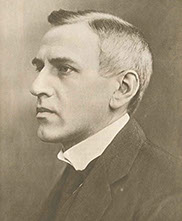Wilhelm Stenhammar

“What is a song other then spoken melody? The words will give you the melody, you should not want to ‘make up’ something along with it Then the piano part will automatically emerge from out of the melody. In this way, the music is entirely at the service of the poem: deepening, clarifying.” Wilhelm Stenhammar

Karolina Hartman – mezzosoprano
Florian Just – Baritone
Maurice Lammerts van Buren – piano
Narrator
A special program around composer, pianist and conductor Wilhelm Stenhammar (1871-1927) with two singers, a pianist and a narrator. In letters, notes, reviews and of course in music, a picture is sketched of the life and work of Stenhammar and the musical life in Sweden around 1900.
Around this time, a very interesting and dynamic time began for Swedish song art. To give an impression of music and concert life during this period, it can be said that a concert program without singing was almost impossible to find. Song recitals were extremely popular and always sold out.
The composer, conductor and pianist Wilhelm Stenhammar, little known outside of Sweden, certainly deserves more attention. He was a born musician and craftsman who is indispensable for Swedish musical life. His versatility as a musician was impressive! As a soloist, chamber musician and song accompanist, Stenhammar remained very active and successful for most of his life. Barely twenty years old, he was the piano soloist at the Swedish premiere of Brahm’s first piano concerto. He also gave many lieder recitals with the great Scandinavian singers of that time, often with songs from his Scandinavian colleagues, such as Nielsen, Grieg and Peterson-Berger, but also with songs by the great masters Schubert, Schumann and Brahms. His idealistic belief that music is something that refines and enriches the human mind and a genuine desire to reach a wide audience, bear witness to a sense of cultural responsibility.
As a composer, Stenhammar spent his life looking for a balance between the subjective, romantic and classical form. A refined, intimate and even subdued atmosphere characterizes his (more than a hundred) songs, often with a melancholic undertone, but he also has a deep dramatic insight that leads to passionate expressions. The piano clarifies, supports, sets the mood and illustrates at times. It is touching to read in Stenhammar’s letters and writings about his desire for purity and truthfulness, both in his composing and in life itself!
Programma
Wilhelm Stenhammar
- I skogen (Gellerstedt)
- Till en ros (Runeberg)
- Fantasie op. 11 (pianosolo)
- Du hade mig kär (von Heidenstam)
- Gammal Nederländare (Bergman)
- Positivvisa (Bergman)
- Varför till ro så brått (von Heidenstam)
- Lycklandsresan (Fröding)
- Prins Aladin av lampan (Fröding)
Wilhelm Peterson-Berger
- Intet är som väntans tider (Karlfeldt)
W. Stenhammar
- Fylgia (Fröding)
- Vid fönstret (Bergman)
- Månsken
- Jungfru Blond och Jungfru Brunett
Intermission
Ture Rangström
- Avskedet (Bergman)
- Vingar i natten
W. Stenhammar
- Melodi (Bergman)
T. Rangström
- Melodi
Traditioneel volkslied
- Förgäves uppå stigen (onbekend)
W. Peterson-Berger
- När jag för mig själv (Nyblom)
Hugo Alfvén
- Gammalt kväde från Hälsingland (onbekend)
W. Stenhammar
- Sensommarnätter (pianosolo)
- Lutad mot gärdet (Runeberg)
- Ingalill (Fröding)
- I lönnens skymning (von Heidenstam)
- Adagio (Bergman)
- Minnesång (Karlfeld)
